“Global Large Language Model Powered Tools Market to reach a market value of 24.4 Billion by 2031 growing at a CAGR of 45.5%”
The Global Large Language Model Powered Tools Market size is expected to reach $24.4 billion by 2031, rising at a market growth of 45.5% CAGR during the forecast period.
LLMs have found innovative applications in the creative industries, assisting with scriptwriting, story generation, music composition, and visual art generation. These tools allow creative professionals to experiment with ideas and develop content faster. For example, writers can use LLM-powered tools to generate creative prompts, while artists can employ AI to explore new artistic styles or design concepts. The potential for AI to enhance the creative process is gaining momentum and attracting interest from the entertainment, gaming, and media sectors. As the creative arts industry continues to explore the possibilities of AI-powered creativity, this segment is poised for further growth. Thus, the creative arts segment acquired 12% revenue share in the large language model powered tools market in 2023.
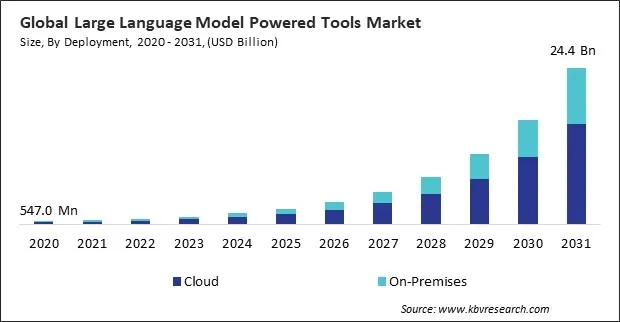
The major strategies followed by the market participants are Product Launches as the key developmental strategy to keep pace with the changing demands of end users. For instance, In May, 2024, OpenAI, LLC partnered with Stack Overflow, a cloud-based solutions provider, to integrate Stack Overflow's OverflowAPI into ChatGPT, providing developers with trusted, vetted technical knowledge. The collaboration would improve AI model performance and enhance the developer experience.
Based on the Analysis presented in the KBV Cardinal matrix; Microsoft Corporation and Google LLC are the forerunners in the Large Language Model Powered Tools Market. Companies such as Meta Platforms, Inc., NVIDIA Corporation, Amazon Web Services, Inc. are some of the key innovators in Large Language Model Powered Tools Market. In January, 2024, Microsoft unveiled new generative AI and data solutions for retailers, including copilot templates on Azure OpenAI Service, retail data solutions in Microsoft Fabric, and new features in Dynamics 365 Customer Insights. These tools aim to enhance personalized shopping, improve store operations, and unify retail data to drive better customer engagement and marketing effectiveness.
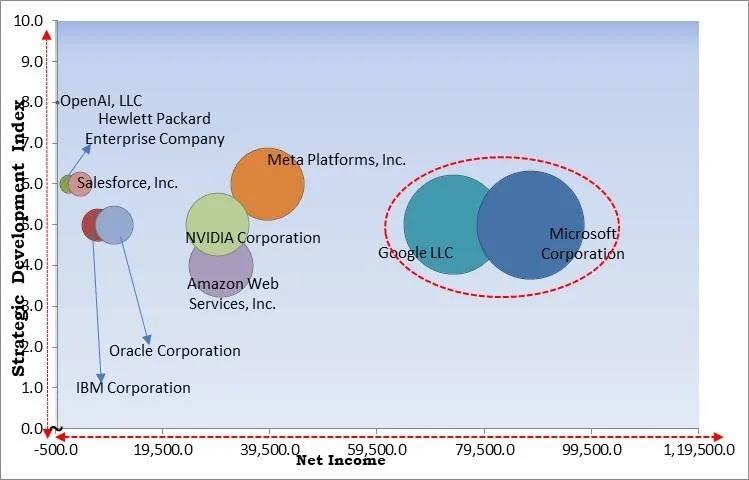
Companies like Netflix and Spotify use these AI tools to improve user experiences through personalized suggestions and responses, boosting customer loyalty. Hence, as the demand for customized and efficient service grows, AI-powered customer support tools continue to gain traction across various sectors, accelerating market growth.
Additionally, platforms like Facebook and Twitter generate vast amounts of text data daily, providing LLMs with rich datasets to improve their language understanding and generation capabilities. The availability of this extensive data is a key driver in advancing LLM-powered tools, as it enables these models to become more accurate, nuanced, and effective in diverse applications. Thus, as data grows in volume, the need for LLM-powered tools across industries will only increase, leading to further market expansion.
Training large language models requires vast amounts of data and high-performance hardware like GPUs and TPUs, which are expensive to acquire and maintain. Smaller companies and organizations often lack the infrastructure to support such intensive computational needs, creating a financial barrier to entering the market or developing proprietary LLMs. Hence, these high costs are a major barrier to the democratization of LLM-powered technologies, limiting their widespread adoption despite the growing demand for advanced AI tools across industries.
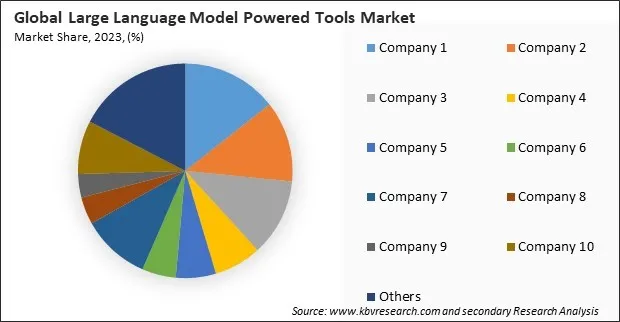
The leading players in the market are competing with diverse innovative offerings to remain competitive in the market. The above illustration shows the percentage of revenue shared by some of the leading companies in the market. The leading players of the market are adopting various strategies in order to cater demand coming from the different industries. The key developmental strategies in the market are Product Launches and Product Expansions.


On the basis of deployment, the market is bifurcated into cloud and on-premises. The cloud segment acquired 67% revenue share in the market in 2023. Cloud-based LLM-powered tools offer several advantages, including scalability, flexibility, and reduced infrastructure costs, making them the preferred choice for many organizations.
Based on type, the market is divided into general-purpose tools, domain-specific tools, and task-specific tools. The domain-specific tools segment procured 38% revenue share in the market in 2023. These tools are designed to understand their domains' specific jargon, regulatory requirements, and operational needs.
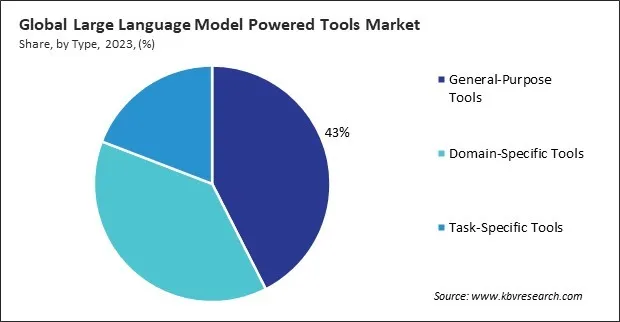
By application, the market is classified into content generation, customer support, data analysis & insights, software development, personalization, language translation, education & training, and creative arts. The content generation segment witnessed 23% revenue share in the market in 2023. The demand for automated and AI-driven content creation has surged across industries like marketing, journalism, eCommerce, and entertainment, where producing large volumes of high-quality text is essential.
Free Valuable Insights: Global Large Language Model Powered Tools Market size to reach USD 24.4 Billion by 2031
Region-wise, the market is analyzed across North America, Europe, Asia Pacific, and LAMEA. The Europe segment witnessed 31% revenue share in the market in 2023. The region has proactively implemented AI regulations, such as the European Union's AI Act, which seeks to foster innovation while ensuring safe and ethical AI deployment.
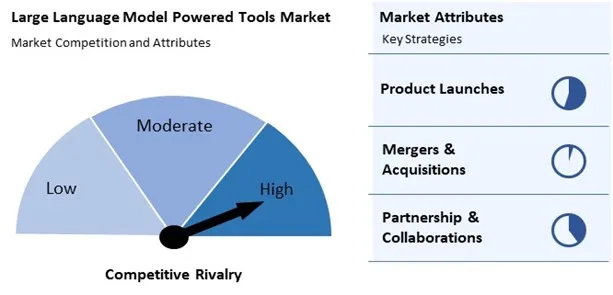
The Large Language Model Powered Tools market is highly competitive, driven by key players innovating in natural language processing and AI capabilities. Attributes defining market leaders include advanced neural network architectures, extensive training data sets, and robust API integration for diverse applications. Emerging trends emphasize model interpretability, multilingual capabilities, and customization for specific domains. Market dynamics are influenced by rapid technological advancements and increasing demand for AI-driven solutions across industries like customer service, healthcare, and content generation.
| Report Attribute | Details |
|---|---|
| Market size value in 2023 | USD 1.3 Billion |
| Market size forecast in 2031 | USD 24.4 Billion |
| Base Year | 2023 |
| Historical Period | 2020 to 2022 |
| Forecast Period | 2024 to 2031 |
| Revenue Growth Rate | CAGR of 45.5% from 2024 to 2031 |
| Number of Pages | 279 |
| Tables | 393 |
| Report coverage | Market Trends, Revenue Estimation and Forecast, Segmentation Analysis, Regional and Country Breakdown, Competitive Landscape, Market Share Analysis, Porter’s 5 Forces Analysis, Company Profiling, Companies Strategic Developments, SWOT Analysis, Winning Imperatives |
| Segments covered | Deployment, Type, Application, Region |
| Country scope |
|
| Companies Included | OpenAI, LLC, Google LLC (Alphabet Inc.), Microsoft Corporation, IBM Corporation, Oracle Corporation, Meta Platforms, Inc., Amazon Web Services, Inc. (Amazon.com, Inc.), Salesforce, Inc., Hewlett Packard Enterprise Company and NVIDIA Corporation |
By Deployment
By Type
By Application
By Geography
This Market size is expected to reach $24.4 billion by 2031.
Rising adoption of AI-powered customer support are driving the Market in coming years, however, High computational costs of LLM-powered tools restraints the growth of the Market.
OpenAI, LLC, Google LLC (Alphabet Inc.), Microsoft Corporation, IBM Corporation, Oracle Corporation, Meta Platforms, Inc., Amazon Web Services, Inc. (Amazon.com, Inc.), Salesforce, Inc., Hewlett Packard Enterprise Company and NVIDIA Corporation
The expected CAGR of this Market is 45.5% from 2024 to 2031.
The General-Purpose Tools segment is leading the Market by Type in 2023; thereby, achieving a market value of $9.9 Billion by 2031.
The North America region dominated the Market by Region in 2023 and would continue to be a dominant market till 2031; thereby, achieving a market value of $8,405 million by 2031.
Our team of dedicated experts can provide you with attractive expansion opportunities for your business.
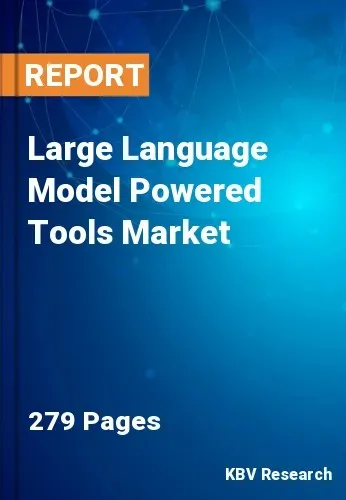
 Drivers
Drivers
 Restraints
Restraints
 Opportunities
Opportunities
 Challenges
Challenges
